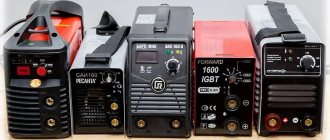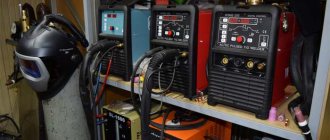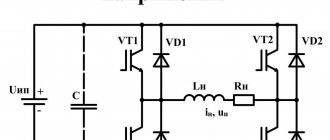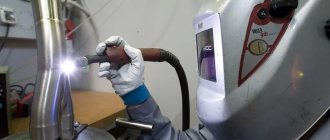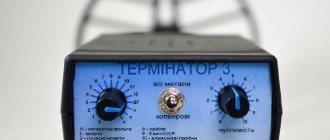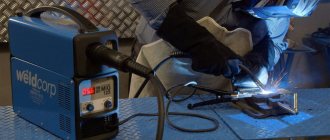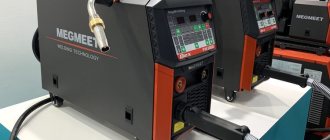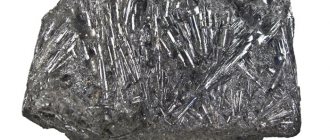Welding is a technological process in which a large number of parameters and factors must be taken into account. The greatest control over welding characteristics is required when argon-arc welding TIG with a non-consumable electrode in an environment of protective inert gases. Therefore, to simplify monitoring of a number of parameters in welding inverters, a cyclogram is used.
Using a cyclogram, the welder sets the necessary welding parameters so that the process does not cause difficulties, as well as to prevent various defects. Let's look at the cyclogram of the welding machine PTK MASTER TIG 200 P AC/DC D92.
Each parameter of the cyclogram is important, so to obtain high-quality welded joints you need to understand why it is needed and how to configure it. Let's take a closer look at each of them.
Gas supply time before welding
This is a parameter that increases the delay time for the high-frequency oscillator to operate, while the gas valve in the device is in the open position, thereby supplying shielding gas to the burner. Typically has an adjustment range from 0.1 to 10–15 seconds. Adjusting this parameter allows you to expel excess oxygen from all channels of the argon-arc torch so that it does not enter the welding zone and fill the welding seam with vapors, because inert gases are heavier than air and displace oxygen from the welding zone.
Advice. The recommended gas supply time is from 1.0 to 2.0 seconds. This is quite enough to expel air from all channels and not waste shielding gas in vain.
Manipulating a TIG torch
Many models of welders for argon-arc welding provide two types of arc ignition - contact and high-frequency. The second option is optimal both for experienced welders due to its convenience, and for beginners who do not want to take risks due to the likelihood of incorrect process settings. High-frequency ignition of the arc does not allow burning through the workpiece, does not leave tungsten particles on it and does not contaminate the electrode itself. In addition, the performer gets the opportunity to clearly control the distance between the electrode and the surface of the structures being welded.
Some recommendations for burner position. If TIG welding of metals is carried out without the use of a filler rod, the nozzle should be kept perpendicular to the plane being welded. If an additive is used, the angle should be selected within 70°-80°. The rod should be positioned at an angle to the workpiece of 15°-20° and perpendicular to the plane of the nozzle. The recommended length of the welding arc should not be more than 3 mm.
The filler wire should be supplied to the working area only after the formation of the weld pool - not earlier and not later. If you are late, there is a risk of burning the workpiece. This skill will require some experience to master. Therefore, beginners will need to practice it on samples.
Upon completion of work, the burner should not be removed immediately. By blowing the working area with inert gas, the contractor ensures that there are no hidden defects in the seam.
All of the above must be performed with strict adherence to the safety rules applicable to any welding process. And if you are still thinking about which welding machine for TIG welding to purchase, we recommend that you familiarize yourself with our catalog. We offer you a wide selection of the best welders for connecting elements made of non-ferrous and ferrous metals in an argon environment. Products from leading brands at the best prices embody the most modern technological developments.
Welding TIG metals using the best inverters from our online store is the key to high quality work and its high efficiency!
Peak current
Or the main current for arc welding without a pulse is the main welding parameter that forms the weld pool and weld seam. When welding with a pulsed arc, this is the upper limit of the welding current, which also forms the weld seam. Typically has a range from 5–15 Amps to the maximum welding current of the machine.
Advice. It is better to set the starting current to a higher peak (main) current of 10–20 Amps in order to quickly form a weld pool without further overheating of the base metal. It is better to set the current decay time from 1.5 to 2.0 seconds, so as not to heat the metal for a long time and not get burned.
Welding clothing and protective equipment
To safely carry out the argon arc welding process, it is necessary to wear special clothing and protective equipment. Such protective equipment includes: a shield, a welder's mask, welder's glasses, protective glasses and light filters. The welder's mask is one of the most important components of the welder's protective equipment. After all, both his health and life depend on this.
It is not for nothing that a welder’s mask is considered the most important component of protective equipment when performing argon arc welding. This is due to the fact that it protects against several types of negative health effects on the welder during the welding process. Such negative consequences include: damage to the respiratory system, damage to the cornea of the eyes.
Welding metal in an argon environment produces a durable, beautiful seam
The welder's mask is made of lightweight, non-conductive, heat-resistant and non-toxic material. A darkened screen is built into the body of such a mask, which protects against radiation and provides the necessary visibility when carrying out argon arc welding. The screen should consist of ordinary protective glass, a light filter and plastic film. The outer glass helps prevent metal splashes from entering the filter. The inside of the light filter must be covered with colorless safety glass to protect the welder’s eyes and face from damage from fragments.
Argon welding technology means that the welder must be dressed in special clothing. As a rule, this is a canvas suit: trousers, jacket, apron and arm ruffles.
The welder's special shoes (boots) should protect him from contact with heated surfaces. Welder gloves protect the skin of the hands from splashes and sparks when welding with argon. The welder must also have a gas mask or dust respirator, which must be used when the maximum permissible concentration of gas and dust increases.
Base current
An indicator that, in combination with the peak current, produces a pulsed arc with a certain frequency that can be adjusted. The base current sets the lower limit of the pulse. Used when welding thin sheet metal to prevent overheating, burnout of alloying elements, burns and warping. The base current allows you to keep the weld pool from failure and from burning through. The standard adjustment range is from 5–15 Amps to the maximum value of the welding current of the machine.
This parameter will only be active in AC Pulse and DC Pulse mode, i.e. when welding with a pulsed arc, in other modes this parameter will not work.
Features of welding aluminum with argon
When performing work, you need to take into account the unusual characteristics of this metal:
- Due to increased chemical activity, the surface of aluminum upon contact with air is quickly covered with an oxide film. It melts at a temperature of more than 2000⁰C, and metal - 660⁰C. If hard pieces of film get into the seam, its strength will decrease.
- When welding aluminum, it is difficult to control the process, since its color does not change after melting.
- The material is hygroscopic, therefore it absorbs atmospheric moisture, which, when heated, evaporates from the surface, reducing the quality of the connection.
- Due to the high coefficient of linear expansion, the joint may become deformed and crack when cooling. To compensate for shrinkage, argon welding is carried out with increased wire consumption or the seam is modified.
- If the gas flow is incorrectly adjusted when performing argon welding of aluminum, it foams when there is a shortage, and when there is an excess, it makes it difficult to form a seam.
TIG welding machines
Article: 005.100.302 PTK MASTER TIG 200A F55
Direct current (DC) argon arc welding machine. Availability of an additional function of manual arc welding. 2 year warranty.
Price: RUR 32,731
5 year warranty Article number: 005.300.471 PTK RILON TIG 200 P AC/DC GDM
Device for argon arc welding with direct (DC) and alternating current (AC). Pulse welding. Manual arc welding (MMA) function. 5 year warranty.
Price: RUB 97,124
5 year warranty Article number: 005.300.371 PTK RILON TIG 200 P GDM
Direct current (DC) argon arc welding machine. Pulse mode for welding metal of small thicknesses. Manual arc welding (MMA) function. 5 year warranty.
Price: RUB 50,889
5 year warranty Article: 005.300.301 PTK RILON TIG 200 CT
Direct current (DC) argon arc welding machine. Manual arc welding (MMA) function. 5 year warranty.
Price: RUR 45,068
5 year warranty Article: 005.300.406 PTK RILON TIG 315 P AC/DC
Industrial welding machine TIG 315 AC/DC, which is ideal for welding aluminum and its alloys, as well as all types of steel, nickel and copper. Welding on direct and alternating current with pulse. Additional MMA welding function. 5 year warranty.
Price: RUB 142,620
Article: 005.100.373 PTK MASTER TIG 200 P AC/DC D92
Device for argon arc welding with direct (DC) and alternating current (AC). Pulse welding and the presence of an additional function of manual arc welding (MMA). 2 year warranty.
Price: RUB 76,612
Article: 005.100.372 PTK MASTER TIG 200 PULSE D91
Direct current (DC) argon arc welding machine. Pulse mode for welding metal of small thicknesses. MMA welding with hot start and arc afterburner settings is possible. 2 year warranty.
Price: RUR 39,323
Article: 005.200.403 PROFI TIG 315 P AC/DC
Welding inverter for industrial use from a network of 380±15%. Used for direct current (DC) argon arc welding and alternating current (AC) aluminum welding. Availability of MMA welding. Connection to the remote control. The burner is connected to the BJO.
Price: RUB 129,716
Article: 005.200.401 PROFI TIG 200 P AC/DC
Device for industrial use from a network of 220±15%. Used for direct current (DC) argon arc welding and alternating current (AC) aluminum welding. Availability of MMA welding. Connection to the remote control.
Price: RUR 87,526
Preparing the argon arc apparatus for operation
All components are at hand. Putting it all together:
- We install the reducer on the gas cylinder
- Connect the gas hose to the reducer
- Connect the bayonet connector of the torch to the negative connector
- Connect the control cable to the five-pin connector on the front panel
- Lastly, connect the ground cable to the positive connector.
The device is almost ready for use, now let’s move on to assembling the TIG torch:
First install the collet holder
Carefully insert the collet into it
Screw the shank (not all the way)
Installing a ceramic nozzle
Insert tungsten electrode
6. Adjust the electrode extension
7. Tighten the shank thoroughly.
Once everything is done, we set the gas flow depending on the location and nozzle diameter. For a nozzle with a diameter of 10 mm, a gas flow rate of 10 l/min is quite suitable.
Attention! In addition to the apparatus itself and the burner, the workpieces also require preparation. By cleaning them from rust, oxide film and other contaminants, you will take care of the quality of welding. For degreasing, you can use acetone, white spirit or another solvent. The filler rod is also sanded and degreased.
What must be considered when argon welding aluminum?
Argon welding is quite universal, which allows you to join different thicknesses of materials using this method and work with alloys that are considered difficult to weld. The basis is an electric arc burning between a tungsten electrode and the product. Its appearance is ensured by direct or alternating current supplied to the torch and the mass attached to the parts being welded. The inert gas acts as a protection for the weld pool. But aluminum and its alloys have a number of specific features that need to be known and taken into account when welding.
One of the difficulties is the oxide film that forms on the surface of the material. It appears when metal interacts with oxygen. The film melts at a temperature of 2000 degrees. But aluminum itself begins to take on a liquid form after 500 degrees. Therefore, by choosing too high a current and melting the oxide, it is impossible to weld. By setting small parameters on the device, it is not possible to begin the process of creating a weld pool at all. Therefore, argon arc welding of aluminum involves preliminary cleaning of the metal surface from oxide. This is achieved with a special brush or solvent, after which it is necessary to immediately begin the welding process.
An additional difficulty is the hygroscopicity of the material. When the ambient humidity is high, aluminum absorbs some of the water from the air. When the product begins to be heated by an electric arc, the material being welded releases moisture to the surface. This may affect the quality of seam formation, the density of contact with the product, and low-voltage pinching of the welder in contact with wet areas. Although you can cook with argon immediately, it is recommended to slightly heat the material with a gas burner at a temperature of 150 degrees. This will allow excess moisture to evaporate and improve the welding process.
Argon welding of aluminum also requires good protection of the molten metal from external air. To do this, you need to set the correct gas flow. Insufficient supply of the latter will lead to foaming of the metal and burning of tungsten. Excessive argon purging will interfere with weld formation and will make the process more expensive.
Another difficulty for novice welders is the formation of a funnel at the end of the seam. If the arc is abruptly interrupted, a crater appears. Holding the torch in one place for a long time leads to unnecessary heating and expansion of the weld pool. Therefore, argon-arc welding of aluminum alloys requires additional settings for the arc attenuation mode, which gradually reduces the current strength. Taking into account these characteristics of the material, you can correctly set the voltage parameters and make a high-quality seam with your own hands.
Electrode selection
The technology of welding aluminum with argon also requires the correct choice of a tungsten electrode, the diameter of which should be as close as possible to the thickness of the parts being welded. Sharpening is done in the classic way, but without a sharp tip, as is the case with stainless steel welding. During the first seconds of combustion, the electrode will take the shape of a drop at the end and the seam will have to be made this way. The projection from the nozzle is required to be 3-5 mm to avoid overheating of the tungsten. When welding, small spatters of aluminum will stick to the electrode, requiring re-sharpening.
Learning to weld aluminum is not easy. But knowing the above principles and watching videos with lessons from experts, you can confidently try your hand at practice.
Source: svarkalegko.com
Article rating:
Save to:
Argon arc welding, setting up the machine Link to the main publication
Welding accessories. Selection of components
Let's figure out what consumables are needed to weld an aluminum alloy. The first step is to understand the type of aluminum welding. For TIG and MIG welding, the set of components will be different.
For any type of welding, you will need shielding gas, which is connected directly to the machine during operation. For aluminum welding, only inert gases argon, helium or mixtures thereof are used.
When choosing the type of gas, keep in mind that helium is preferable to use when welding thick-walled parts. Due to the higher thermal conductivity of helium, it is possible to maintain a higher temperature in the weld pool, which has a better effect on the quality of the weld at large thicknesses.
Device setup and modes
TIG welding of aluminum is possible only where the machines support operation not only with direct current, but also with alternating current. Despite the frequency of voltage fluctuations, the best seam is obtained with the last setting. Polarity can be either direct or reverse. Voltage parameters can be set based on the thickness of the material:
| We accept orders from 8.30 to 21.00 Mon-Sun | ||
| Plate thickness, mm | Current strength, A | Diameter of tungsten electrode, mm |
| 1 | 30 — 40 | 1.6 |
| 1.5 | 45 — 60 | 2.3 |
| 2 | 70 — 80 | 2.3 |
| 3 | 90 — 120 | 3.2 |
It is important to install the current supply in a stepwise manner, with a smooth ignition, an ascending value during the welding process, and a gradual attenuation when combustion is completed. This will avoid creating a crater at the end of the connection.
The argon consumption during welding is set on the pressure gauge closest to the gas hose. Russian models need to be installed in the range from 6 to 11 liters. This is the error of the measuring device, which is brought to the optimal value only by practical means. If the pressure gauge is imported (German, Czech), then you can immediately supply 8 liters.
In the device settings, it is important to set the subsequent gas purging time after the arc stops burning. The duration of argon supply is set to five seconds, which gives enough time for the bath to solidify and cool the electrode.
How to weld aluminum using argon arc welding
It is possible to ensure high-quality connection of aluminum parts only by TIG welding. A regular electrode can weld aluminum alloy for strength, but it will require longer post-processing. Welding aluminum with argon allows you to work with material of different thicknesses, creating neat seams with good sealing properties. This is especially in demand when repairing cars, boats or various containers. But how to cook this specific material for the first time? How to set up equipment when welding aluminum? A short guide from the article and video lesson will help you master this complex matter.
